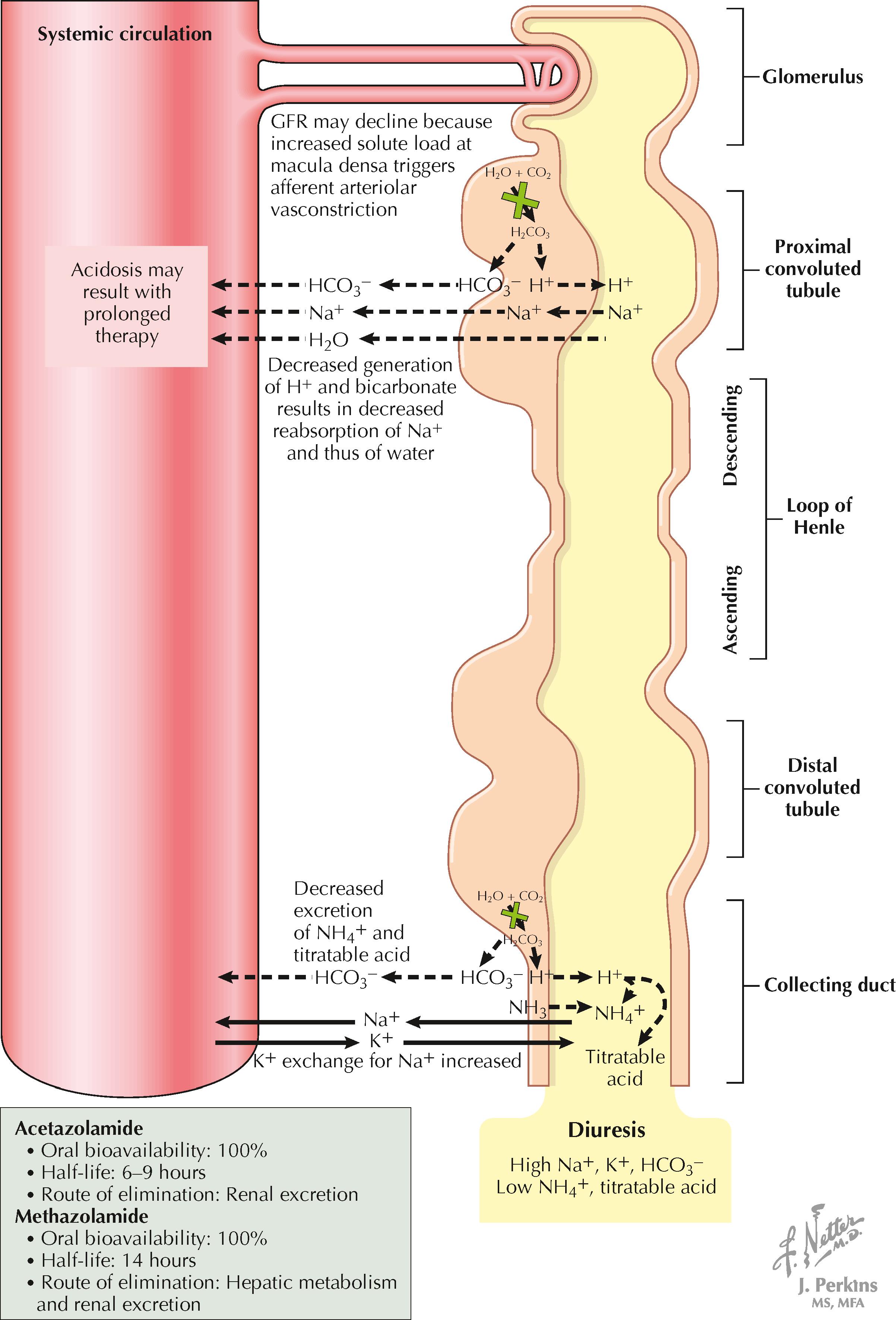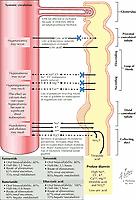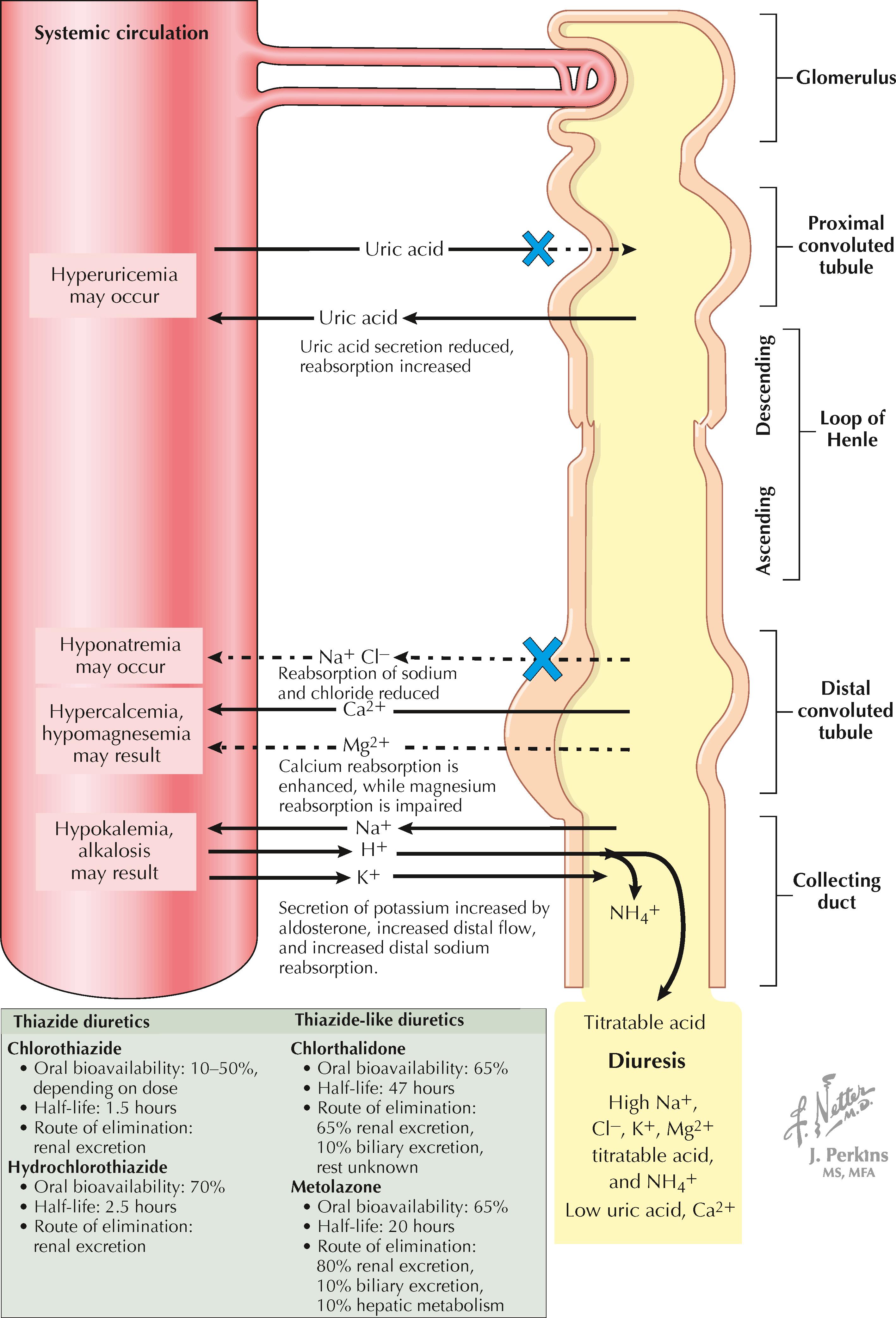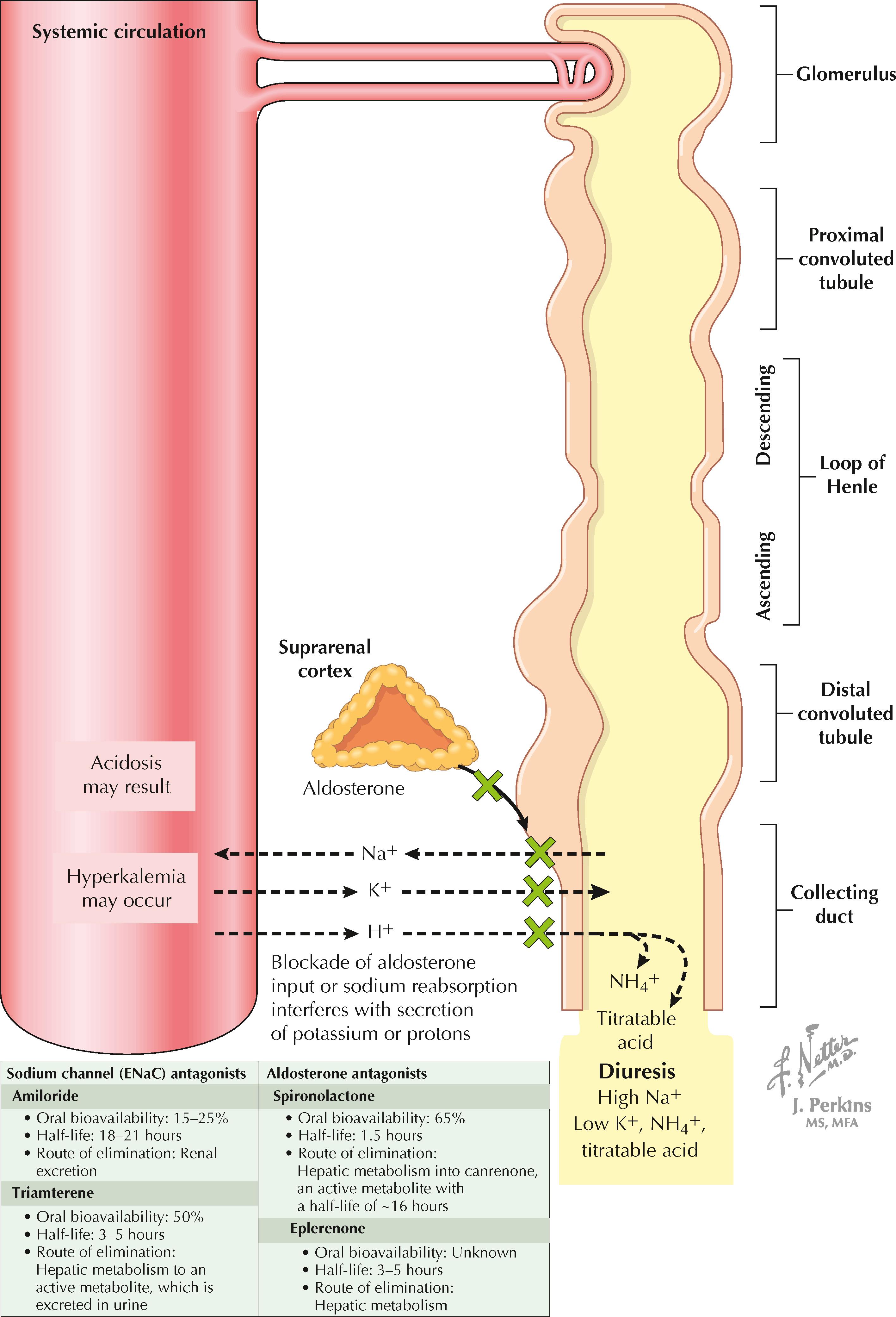Physical Address
304 North Cardinal St.
Dorchester Center, MA 02124
In the nephron, water reabsorption is a passive phenomenon that relies on the transcellular osmotic gradients established during the reabsorption of solutes, especially sodium. Osmotic diuretics alter these gradients to produce diuresis. After intravenous administration, such agents undergo filtration at the glomerulus but then cannot be reabsorbed. As sodium and water are reabsorbed, osmotic diuretics become more concentrated in the tubular lumen, eventually generating an osmotic gradient that interferes with further fluid reabsorption. In the proximal tubule, the decreased fluid reabsorption also establishes a transepithelial sodium concentration gradient, normally prevented by the iso-osmotic reabsorption of water, that limits further sodium reabsorption.
In the general circulation, osmotic agents are also restricted to the extracellular space. As a result, fluid shifts from the intracellular to extracellular space, expanding the extracellular volume. An increase in renal blood flow ensues, which is transmitted to the medullary microcirculation and causes solute wash-out from the interstitium. As a result, there is a reduced gradient for water reabsorption from the collecting duct, promoting further water losses.
The major osmotic diuretic is mannitol, which has a half-life of 0.25 to 1.7 hours and primarily undergoes renal excretion.
The most common indications for mannitol include:
Acute kidney injury , although several randomized controlled studies have found that mannitol offers no benefit in this setting.
Cerebral edema. Mannitol is restricted from the brain by the blood-brain barrier. Therefore, its presence in the general circulation produces an osmotic gradient that promotes a shift of free water from the cerebrospinal fluid to the blood.
Acute closed-angle glaucoma . For the reasons described, mannitol can promote fluid shifts from the eye into the general circulation.

The major adverse effects of mannitol include:
Hyponatremia/hypernatremia . Osmotic agents are associated with an initial phase of hyponatremia, which results from the systemic efflux of intracellular fluid in response to extracellular hyperosmolality (“pseudohyponatremia”). As free water is excreted with mannitol in the urine, hypernatremia follows, which can cause mental status changes, headache, lethargy, and nausea.
Hyperkalemic acidosis . As water is drawn out of cells, the intracellular concentrations of potassium and protons can rise, prompting their efflux through membrane channels. Hyperkalemic acidosis may persist in patients with poor renal function, who cannot eliminate the excess extracellular potassium or protons.
Pulmonary edema owing to the expansion of extracellular volume
Carbonic anhydrase (CA) catalyzes the interconversion of carbon dioxide and water to bicarbonate (HCO 3 − ) ions and protons. There are multiple CA isoforms, which serve different functions in cells throughout the body. In the renal tubules, the epithelial cells involved in acid-base handling—such as those in the proximal tubule, thick ascending limb, and the cortical collecting duct—possess cytoplasmic CA-II and luminal membrane-bound CA-IV. Several other CA isoforms also appear to be present throughout the nephron, with their locations and functions still under active investigation.
As reviewed in Plates 3-21 and 3-22 , CA plays crucial roles in acid-base homeostasis and solute reabsorption. In the proximal tubule, for example, membrane-bound CA-IV catalyzes the conversion of filtered bicarbonate ions and secreted protons into carbon dioxide, which is reabsorbed across the apical surface of proximal tubular cells. Cytoplasmic CA-II, meanwhile, converts the reabsorbed carbon dioxide back into bicarbonate ions, which are reabsorbed, and protons, which are secreted on the NHE-3 Na + /H + exchanger. Meanwhile, in more distal segments, cytoplasmic CA-II converts carbon dioxide to new bicarbonate ions, which are reabsorbed, and protons, which are secreted and bound in the tubular lumen to titratable acids and ammonia.
CA inhibitors (CAIs) are sulfonamide derivatives that block the actions of both cytoplasmic and membrane-bound CA isoforms throughout the nephron. As a result, CAIs cause an increased fraction of the filtered bicarbonate to be excreted, rather than reabsorbed. In addition, these agents impair protonation of titratable acids and ammonia in the distal nephron. Because of these effects, the urine becomes inappropriately alkalotic, and metabolic acidosis ensues.
In addition to their effects on acid-base equilibrium, CAIs also impair proximal Na + reabsorption, since operation of the NHE-3 exchanger depends on the presence of protons in the cytoplasm of tubular epithelial cells. The natriuretic effect of this action, however, is largely offset by upregulation of distal Na + reabsorption sites, such as the thick ascending limb, that possess proton-independent Na + transport mechanisms. Moreover, the increased solute load delivered to the macula densa stimulates afferent arteriolar vasoconstriction, reducing the glomerular filtration rate.
Because CA is widely distributed through the body, CAIs have multiple extrarenal effects that render them useful in other clinical settings. In the ciliary processes of the eye, for example, CAIs reduce the production of aqueous humor, making them effective agents in the treatment of glaucoma.
The major CAIs are listed in the plate.
The most common indications for CAIs include:
Edema , but they are rarely given for this indication because other diuretic classes are safer and more effective.
Acute mountain sickness . At high altitudes, the low partial pressure of oxygen induces hyperventi-lation. This response improves tissue oxygenation but is limited by the ensuing respiratory alkalosis. Acetazolamide can be used to induce metabolic acidosis and further increase ventilation.
Open- or closed-angle glaucoma . As described above, CAIs reduce production of aqueous humor in the anterior chamber of the eye. Methazolamide is preferred for this indication because of its long half-life. In closed-angle glaucoma, CAIs can be used as a temporizing measure until definitive treatment is available.

The major adverse effects of CAIs include:
Metabolic acidosis
Nephrolithiasis , owing to urine alkalinization
Increased serum ammonia concentration , secondary to impaired renal excretion, which may cause encephalopathy in patients with cirrhosis
Bone marrow suppression
Skin toxicity
Confusion, drowsiness, and paresthesia , secondary to central nervous system effects
CAIs increase K + excretion in several ways. First, the increased Na + load that reaches the distal nephron creates a negative intraluminal charge as it is reabsorbed, which promotes K + secretion through apical renal outer medullary potassium (ROM-K) channels. Second, the increased HCO 3 − load that reaches the distal nephron also generates a negative intraluminal charge, which promotes K + secretion for the same reasons. Finally, the increased urine flow through the distal nephron promotes K + secretion through flow-sensitive maxi-K channels. Such kaliuresis, however, rarely leads to hypokalemia because metabolic acidosis stimulates K + efflux from cells in exchange for H + influx.
In the thick ascending limb (TAL), Na + , K + , and Cl − are reabsorbed across the apical surface of the tubular epithelium on NKCC2 transporters. Such reabsorption is essential for the maintenance of a high medullary interstitial solute gradient, which permits urine concentration in the collecting duct (see Plate 3-15 ). In addition, recycling of the reabsorbed potassium back into the lumen through apical ROMK channels establishes the positive intraluminal charge required for reabsorption of Ca 2+ and Mg 2+ (see Plate 3-11 ).
Loop diuretics enter the nephron through the organic anion secretion pathway in the proximal tubule, then they bind to the apical surface of NKCC2 transporters and inhibit their function.
Because the distal nephron is unable to reabsorb the large sodium load rejected from the thick ascending limb, the diuresis associated with these drugs is profound. In addition, loop diuretics also have weak diuretic effects elsewhere in the nephron. In the proximal tubule, for example, some loop diuretics weakly inhibit carbonic anhydrase. Meanwhile, in the distal nephron, some loop diuretics weakly inhibit the thiazide-sensitive NCC Na + /Cl − symporter.
Loop diuretics also influence the excretion of several other ions. The reabsorption of both Ca 2+ and Mg 2+ is decreased because of the reduction in K + recycling in the TAL. In addition, loop diuretics both increase uric acid reabsorption (by promoting fluid losses, which enhances proximal uric acid reabsorption) and decrease uric acid secretion (by competing with it at the organic anion secretion pathway). Finally, loop diuretics promote K + secretion through various mechanisms. First, the increased Na + load that reaches the cortical collecting duct creates a negative intraluminal charge as it is reabsorbed, promoting K + secretion through apical ROM-K channels. Second, the increased urine flow through the cortical collecting duct upregulates flow-sensitive maxi-K channels.
Because NKCC2 transporters have an essential role in tubuloglomerular feedback and the regulation of renin secretion, loop diuretics also affect both of these processes. As shown in Plate 3-18 , a reduction in NKCC2 transport is normally associated with a reduction in the glomerular filtration rate (GFR) because a slower urine flow rate allows the proximal tubule to capture a greater fraction of the filtered ions. The normal response to a reduction in NKCC2 transport is dilation of the afferent arteriole, which normalizes the glomerular filtration rate, and release of renin, which activates the renin-angiotensin-aldosterone system.
In the presence of a loop diuretic, NKCC2 transport is blocked. As a result, there is chronic dilation of the afferent arteriole despite high flow rates through the nephron, which enhances fluid losses. In addition, there is chronic secretion of renin, which leads to increased synthesis of angiotensin and aldosterone. The result is a further increase in K + secretion, which contributes to the development of hypokalemia, and an increase in H + secretion, which can result in metabolic alkalosis.
The efficacy of loop diuretics can become limited over repeated doses for several reasons. In part, this effect occurs because the distal nephron increases its reabsorptive capacity, blunting the efficacy of loop diuretics and markedly increasing salt retention between doses. Therefore, to maximize the response to a loop diuretic, patients should be maintained on a low-salt diet, dosed frequently enough to limit the time available for postdiuretic salt retention, and offered simultaneous treatment with drugs that target the distal nephron, such as thiazides.

The major loop diuretics are listed in the plate.
The major indications for loop diuretics include:
Peripheral or pulmonary edema
Hypertension
The major adverse effects of thiazide diuretics include:
Ototoxicity , manifest as tinnitus, vertigo, or hearing loss
Hypokalemia
Hypomagnesemia
Hyponatremia . By inhibiting solute reabsorption in the TAL, loop diuretics prevent maximal urine dilution. In addition, significant fluid losses can trigger release of antidiuretic hormone (see Plate 3-17 )
Hyperuricemia , which may precipitate gout attacks
Hypotension , if excessive extracellular fluid is lost
Metabolic alkalosis , resulting from aldosterone re-lease secondary to volume losses and, if hypoka-lemia is present, an increase in proximal tubular ammoniagenesis
Impaired glucose tolerance or diabetes mellitus secondary to multiple mechanisms, including catecholamine release (secondary to activation of the sympathetic nervous system resulting from volume depletion), as well as reduced insulin secretion (secondary to hypokalemia)
Hyperlipidemia , through mostly unknown mechanisms
Photosensitivity
Paresthesia
In the distal convoluted tubule, Na + and Cl − are reabsorbed across the apical surface of the tubular epithelium on NCC symporters. The thiazide diuretics enter the nephron through the organic anion pathway in the proximal tubule, then they bind to the apical surface of NCC symporters and inhibit them.
Because the vast majority of Na + reabsorption occurs in earlier nephron segments, particularly the proximal tubule and thick ascending limb, thiazides induce only a modest degree of natriuresis. Some agents, however, are also weak carbonic anhydrase inhibitors (see Plate 10-2 ) and thus partially inhibit Na + reabsorption in the proximal tubule.
Thiazides also affect the handling of several other ions. For example, they promote kaliuresis through numerous mechanisms. First, the increased Na + load that reaches the cortical collecting duct leaves a negative charge in the lumen as it is reabsorbed, which promotes K + secretion through apical ROM-K channels. Second, the increased urine flow through the cortical collecting duct up-regulates apical maxi-K channels. Finally, volume losses lead to aldosterone release, which further increases distal K + (and H + ) secretion.
Thiazides also enhance calcium reabsorption through several mechanisms. First, blockade of NCC transport decreases intracellular Na + concentrations, increasing the gradient for basolateral Na + /Ca 2+ exchange. Second, volume losses stimulate reabsorption of Na + and Cl − in the proximal tubule, enhancing the gradient for paracellular calcium reabsorption. (For a detailed discussion of calcium handling in the nephron, see Plate 3-11 .) Thiazides also inhibit magnesium reabsorption, likely by interfering with TRPM6-mediated reabsorption in the distal nephron, although the exact mechanism remains unknown.
Finally, thiazides decrease excretion of uric acid. Like the loop diuretics, thiazides likely exert this effect by increasing proximal tubular reabsorption (secondary to fluid depletion) and decreasing proximal tubular secretion (by competing with uric acid on the organic cation secretion pathway).
The major thiazide and thiazide-like diuretics are listed in the plate.
The major indications for thiazide diuretics include:
Edema
Hypertension
Hypocalcemia
Hypercalciuria with recurrent formation of calcium stones (see Plate 6-3 )
Diabetes insipidus (see Plate 3-27 )
The major adverse effects of thiazide diuretics include:
Hypokalemia
Hyponatremia . By inhibiting solute reabsorption in the distal nephron, thiazides prevent maximal urine dilution. In addition, significant fluid losses can trigger release of antidiuretic hormone (see Plate 3-17 ).
Hypercalcemia
Hypomagnesemia (with long-term use)
Hyperuricemia , which may precipitate gout attacks
Metabolic alkalosis , resulting from aldosterone re-lease secondary to volume losses and, if hypokale-mia is present, an increase in proximal tubular ammoniagenesis
Impaired glucose tolerance or diabetes mellitus secondary to multiple mechanisms, including catecholamine release (secondary to activation of the sympathetic nervous system resulting from volume depletion), as well as reduced insulin secretion (secondary to hypokalemia)
Hyperlipidemia , through mostly unknown mechanisms
Nausea and vomiting
Photosensitivity
Erectile dysfunction

In the connecting tubule and cortical collecting duct, principal cells are responsible for K + secretion through two major mechanisms. First, the reabsorption of Na + through apical ENaC channels leaves a negative charge in the tubular lumen, which promotes the secretion of potassium through apical ROM-K channels. Second, increased flow rates through the distal nephron stimulate K + secretion through apical maxi-K channels.
Most diuretics—including carbonic anhydrase inhibitors, loop diuretics, and thiazide diuretics—up-regulate distal K + secretion through several mechanisms. First, these agents interfere with Na + reabsorption in more proximal portions of the nephron, which increases the load that reaches the distal nephron. The increased Na + gradient across the apical surface of principal cells increases reabsorption through ENaC channels, which then leads to increased K + secretion through ROMK channels. Second, these agents cause volume loss, which activates the renin-angiotensin-aldosterone system. One of aldosterone's effects is to up-regulate ENaC channels, which increases Na + reabsorption and, by necessity, also increases K + excretion. Finally, diuretics increase urine flow rates through the distal nephron, which stimulates K + secretion through apical maxi-K channels.
The “potassium-sparing” diuretics interfere with sodium reabsorption across ENaC channels, which produces a small diuretic effect and, more importantly, eliminates one of the major causes of K + secretion. This category of diuretics encompasses two different classes of agents: those that directly block the ENaC channel (amiloride and triamterene) and those that block aldosterone signaling (spironolactone and eplerenone).
ENaC channel blockers enter the nephron through the organic cation pathway in the proximal tubule. Upon reaching principal cells, these agents bind to the ENaC channel from its luminal side, competing with Na + ions for negatively charged sites in the pore. Meanwhile, aldosterone receptor blockers remain in the plasma to act at the basolateral surface of principal cells.
Potassium-sparing diuretics usually have only a small diuretic effect. Nonetheless, they can be useful in combination with other classes of diuretics because of their effects on potassium homeostasis. They can also help offset the increase in distal sodium reabsorption that occurs with the use of other diuretics.
The major potassium-sparing diuretics are listed in the plate.
The major indications for potassium-sparing diuretics include:
Hypokalemia , especially if associated with the use of another diuretic
Liddle syndrome (ENaC blockers)
Primary hyperaldosteronism (aldosterone antagonists)
Congestive heart failure (aldosterone antagonists)
Ascites (aldosterone antagonists)

The major adverse effects of potassium-sparing diuretics include:
Hyperkalemia
Metabolic acidosis . Through the same mechanisms used to reduce K + secretion, these agents also reduce H + secretion into the distal nephron.
Acute kidney injury (triamterene, owing to crystalluria and tubular obstruction)
Nausea, vomiting, and diarrhea
Peptic ulcers (spironolactone)
Headache and lethargy
Rash
Antiandrogenic effects : gynecomastia and/or breast pain, impotence, hirsutism, and irregular menses (aldosterone antagonists, spironolactone more than eplerenone)
As shown on Plate 3-19 , the renin-angiotensin system plays an essential role in the regulation of systemic blood pressure. In brief, renin is released from juxtaglomerular cells in response to decreased renal tubular flow, sympathetic input, or decreased stretch of afferent arterioles. Renin catalyzes the conversion of angiotensinogen to angiotensin I, which is rapidly converted by angiotensin-converting enzyme (ACE) into angiotensin II (AII). AII increases blood pressure through direct vasoconstrictor effects on systemic vessels and through various other mechanisms, including increased sodium reabsorption from the renal tubules, potentiation of sympathetic tone, and stimulation of aldosterone and antidiuretic hormone release.
Several agents can inhibit this system, including ACE inhibitors, angiotensin II receptor blockers (ARBs), and direct renin inhibitors. These agents are powerful antihypertensive medications, but they are also capable of slowing the progression of renal disease. The mechanism by which these agents protect the kidneys is not fully known, but it likely relates in part to their effects on glomerular hemodynamics. Whenever renal disease causes nephron loss, there is compensatory hyperfiltration of the remaining nephrons that is mediated, at least in part, by AII-dependent constriction of efferent arterioles. Although this response allows the kidneys to temporarily maintain high levels of filtration function, it is ultimately maladaptive because the high intraglomerular pressure causes capillary wall damage, leading to worsening proteinuria and glomerulosclerosis. By relieving constriction of the efferent arterioles, these drugs lower intraglomerular pressure, reducing proteinuria and protecting the glomerular capillary walls. Although this effect is renoprotective in the long term, it is associated with a reversible and expected 20% to 30% decline in glomerular filtration rate (GFR) at the onset of drug therapy, especially if other diuretics are also used. In most patients, however, this effect should not be a reason to stop treatment.
ACE inhibitors prevent the ACE-mediated conversion of angiotensin I to angiotensin II, thereby interfering with the latter's prohypertensive effects. These agents also inhibit other ACE-mediated pathways, which may contribute to their clinical effect. For example, they also inhibit the metabolism of bradykinins, which promote vasodilation and upregulate prostaglandin synthesis.
ACE inhibitors can be broadly classified as sulfhydryl-containing, carboxyl-containing, or phosphinyl-containing. In addition, some of these agents directly block ACE, whereas others must first undergo transformation into active metabolites.
The major indications for ACE inhibitors are:
Hypertension , especially in patients with congestive heart failure, diabetes mellitus, and, or renal insufficiency
Systolic left ventricular dysfunction, since these agents reduce afterload and inhibit ventricular remodeling
Chronic kidney disease
The major adverse effects of ACE inhibitors include:
Cough , owing to increased levels of bradykinin and prostaglandins
Angioedema , also thought to be bradykinin-mediated
Hypotension , generally at the onset of drug treatment
Hyperkalemia , owing to reduced aldosterone levels, especially when used in combination with a potassium-sparing diuretic
Acute kidney injury . Although some decline in GFR is expected, patients with renal artery stenosis (see Plate 4-36 ) may experience renal failure because they require efferent arteriolar constriction to maintain adequate hydrostatic pressure in the glomerular capillaries
Dysgeusia , especially with captopril
Maculopapular, sometimes pruritic rash
Neutropenia , especially in those with renal insufficiency or autoimmune disease

The ARBs are a class of competitive and noncompetitive antagonists of the AT1 angiotensin receptor. These agents are very similar to ACE inhibitors, but they do differ in several important respects. First, because they do not interfere with bradykinin metabolism, these agents are associated with a much smaller risk of cough and angioedema. Second, ARBs are theoretically more potent than ACE inhibitors because they can inhibit the small amount of AII produced through ACE-independent mechanisms. Third, ARBs block AT1 receptors but not AT2 receptors, although the significance of this difference is unclear.
The indications for ARBs are essentially the same as those for ACE inhibitors. In many instances, patients are started on ARBs if they are unable to tolerate the coughing associated with ACE inhibitors. The major adverse effects of ARBs include angioedema (although to a lesser extent than with ACE inhibitors), hyperkalemia, and acute kidney injury, all of which occur through the same mechanisms as with ACE inhibitors.
The direct renin inhibitors (DRIs) block the conversion of angiotensinogen, renin's only known substrate, to angiotensin I. Thus, unlike ACE inhibitors, these agents can effectively block the non-ACE conversion of angiotensin I to angiotensin II, and they do not interfere with bradykinin metabolism. Unlike ARBs, they also prevent AT2 receptor-mediated signaling. These drugs have been associated with a reduction of proteinuria in combination with ACE inhibitors and ARBs. Their adverse effect profile appears to be similar to that of ARBs.
A renal biopsy yields a small piece of renal parenchyma for histopathologic examination. Because many renal diseases have essentially indistinguishable clinical findings, renal biopsy is often crucial for establishing the correct diagnosis and devising an effective treatment plan. The procedure is generally uncomplicated and, in most cases, can safely be performed by a nephrologist at the bedside.
The major indications for renal biopsy include renal failure of unknown cause, proteinuria, hematuria, and renal transplantation.
In patients with mild proteinuria (1 to 2 g/day) that has no obvious cause, such as diabetes mellitus, a renal biopsy may be performed to establish a definitive diagnosis. The exact threshold for biopsy differs across practitioners and depends on individual clinical judgment. Possible causes of this degree of proteinuria include glomerulonephritis and mild forms of the diseases that typically cause nephrotic syndrome, such as focal segmental glomerulosclerosis (FSGS) or membranous nephropathy (MN). Although tubulointerstitial disease commonly causes mild proteinuria, a biopsy is generally not required to establish the diagnosis.
In patients with nephrotic-range proteinuria (i.e., >3 g/day), a renal biopsy is indicated to identify the disease process, guide treatment, and determine prognosis. Possible causes of nephrotic-range proteinuria include primary or secondary FSGS, MN, minimal change disease (MCD), and (rarely) fibrillary or immunotactoid glomerulonephritis. If, however, the patient has a diagnosed systemic illness that is known to cause nephrotic syndrome, a renal biopsy is typically not required. Examples include patients with long-standing diabetes mellitus and concurrent diabetic retinopathy, or patients with amyloidosis seen on a biopsy of another affected organ system. In addition, young children with nephrotic syndrome are generally presumed to have MCD, with a renal biopsy only performed if empiric treatment for this condition fails.
In patients with gross or microscopic hematuria, the initial workup should focus on urologic abnormalities, such as nephrolithiasis, neoplasm, or infection. The presence of dysmorphic red cells, proteinuria, and renal insufficiency, however, strongly points toward glomerular disease. Many renal diseases are associated with microscopic hematuria, including essential hematuria, acute interstitial nephritis, IgA nephropathy, membranoproliferative glomerulonephritis, postinfectious glomerulonephritis, lupus nephritis, cryoglobulinemia, fibrillary/immunotactoid glomerulonephritis, ANCA-associated vasculitis, malignant hypertension, atheroembolic renal disease, renal infarction, thrombotic microangiopathy, Henoch-Schönlein purpura, thin basement membrane nephropathy, hereditary nephritis, and anti-GBM disease. A kidney biopsy is essential for establishing the correct diagnosis and determining an optimal treatment plan.

Occasionally, patients may have isolated hematuria (i.e., without proteinuria or renal insufficiency). The differential diagnosis for such patients includes thin basement membrane disease, mild IgA nephropathy, and hereditary nephritis. A kidney biopsy is typically not performed, however, because treatment is not instituted unless there is significant proteinuria or renal insufficiency.
Patients who have undergone renal transplant and subsequently develop renal failure should have a biopsy if their renal function does not improve after provision of intravenous fluids. In such circumstances, a biopsy is helpful for differentiating between various entities, such as acute or chronic rejection, drug toxicity (especially from calcineurin inhibitors), and BK virus infection. Some centers also routinely take biopsies from transplanted kidneys at predetermined time points, even in the absence of overt dysfunction because some renal disease may initially be clinically silent.
Become a Clinical Tree membership for Full access and enjoy Unlimited articles
If you are a member. Log in here